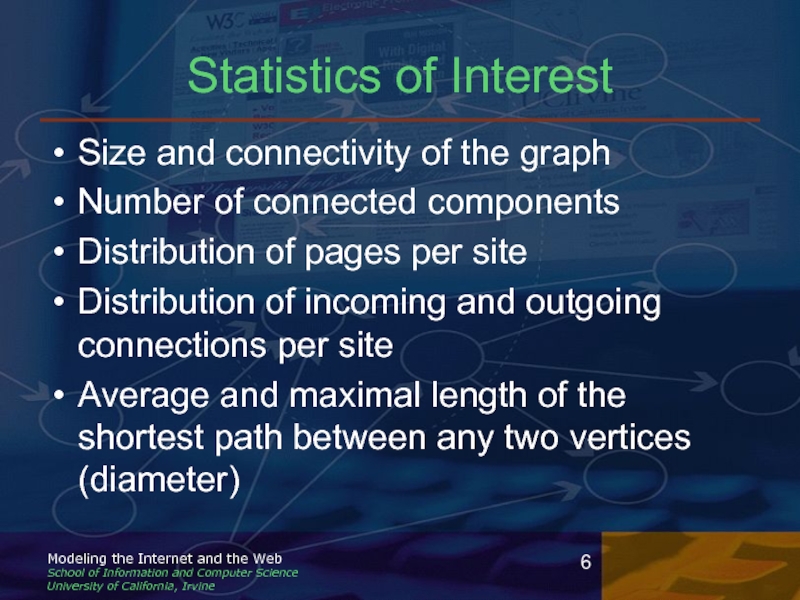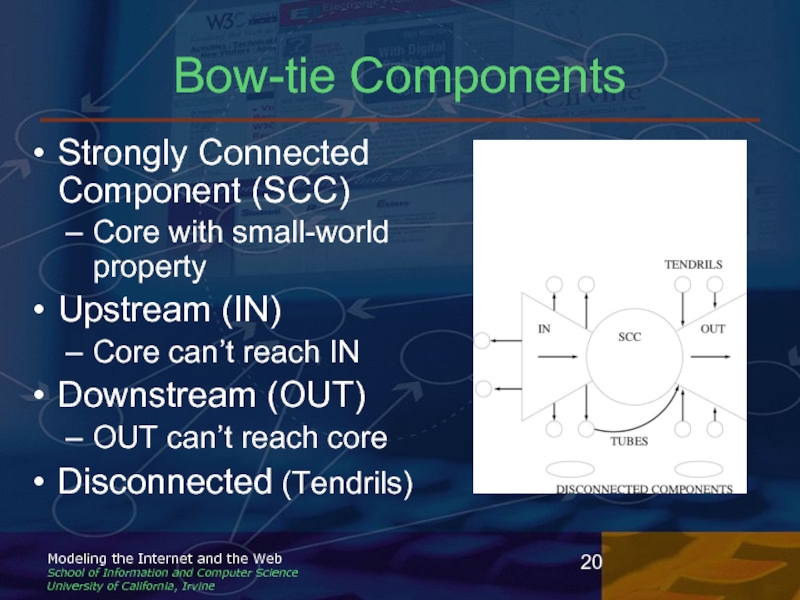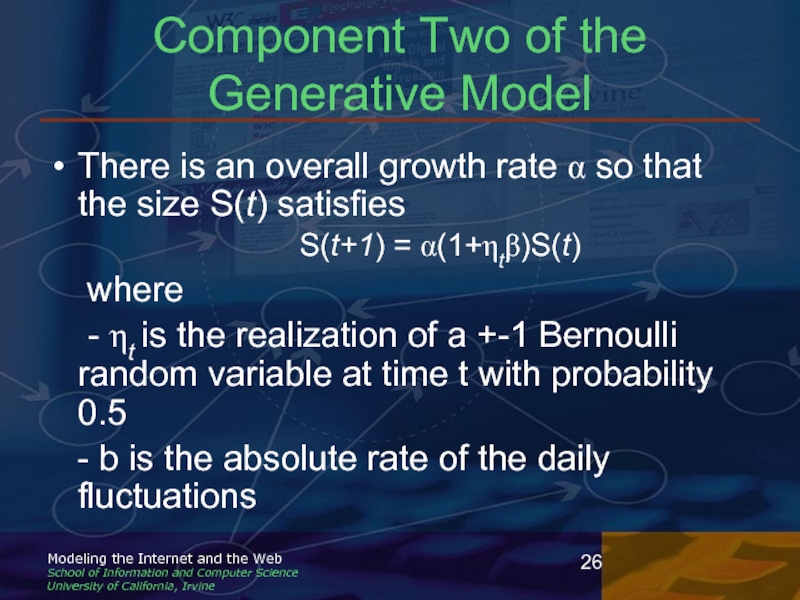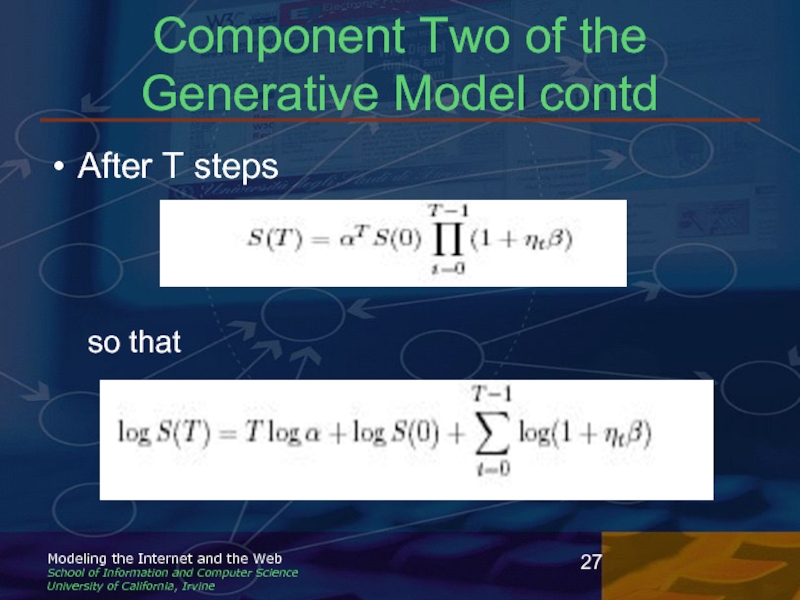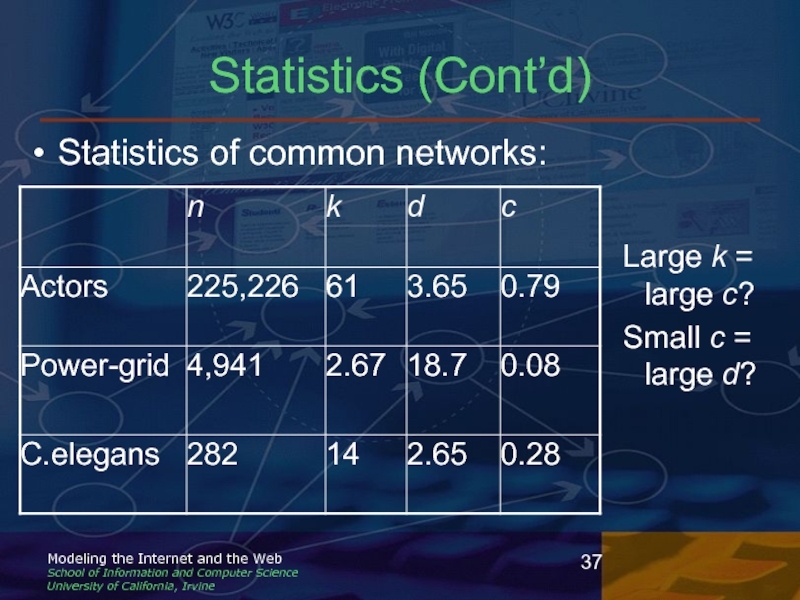- Главная
- Разное
- Дизайн
- Бизнес и предпринимательство
- Аналитика
- Образование
- Развлечения
- Красота и здоровье
- Финансы
- Государство
- Путешествия
- Спорт
- Недвижимость
- Армия
- Графика
- Культурология
- Еда и кулинария
- Лингвистика
- Английский язык
- Астрономия
- Алгебра
- Биология
- География
- Детские презентации
- Информатика
- История
- Литература
- Маркетинг
- Математика
- Медицина
- Менеджмент
- Музыка
- МХК
- Немецкий язык
- ОБЖ
- Обществознание
- Окружающий мир
- Педагогика
- Русский язык
- Технология
- Физика
- Философия
- Химия
- Шаблоны, картинки для презентаций
- Экология
- Экономика
- Юриспруденция
WEB GRAPHS/ Modeling the Internet and the Web School of Information and Computer Science презентация
Содержание
- 1. WEB GRAPHS/ Modeling the Internet and the Web School of Information and Computer Science
- 2. Internet/Web as Graphs Graph of the physical
- 3. Web Graph http://www.touchgraph.com/TGGoogleBrowser.html
- 4. Web Graph Considerations Edges can be directed
- 5. Why the Web Graph? Example of a
- 6. Statistics of Interest Size and connectivity of
- 7. Properties of Web Graphs Connectivity follows a
- 8. Power Law Size Simple estimates suggest over
- 9. Power Law Connectivity Distribution of number of
- 10. Power Law Distribution -Examples http://www.pnas.org/cgi/reprint/99/8/5207.pdf
- 11. Examples of networks with Power Law Distribution
- 12. Small World Networks It is a ‘small
- 13. The small world of WWW Empirical study
- 14. Implications for Web Logarithmic scaling of diameter
- 15. Some theoretical considerations Classes of small-world networks
- 16. Power Law of PageRank Assess importance of
- 17. PageRank contd Page rank r(v) of page
- 18. Examples Log Plot of PageRank Distribution of
- 19. Bow-tie Structure of Web A large scale
- 20. Bow-tie Components Strongly Connected Component (SCC) Core
- 21. Component Properties Each component is roughly same
- 22. Empirical Numbers for Bow-tie Maximal minimal (?)
- 23. Models for the Web Graph Stochastic models
- 24. Web Page Growth Empirical studies observe a
- 25. Component One of the Generative Model The
- 26. Component Two of the Generative Model There
- 27. Component Two of the Generative Model contd
- 28. Theoretical Considerations Assuming ηt independent, by central
- 29. Theoretical Considerations contd Log S(T) can also
- 30. Modified Model Can be modified to obey
- 31. Capturing Power Law Property Inorder to capture
- 32. Lattice Perturbation (LP) Models Some Terms “Organized
- 33. Terms (Cont’d) Organized Networks Are ‘cliquish’ (Subgraph
- 34. Semi-organized (SO) Networks Probability for long-range edge
- 35. Creating SO Networks Step 1: Take
- 36. Statistics of SO Networks Average Diameter
- 37. Statistics (Cont’d) Statistics of common networks:
- 38. Other Properties For graph to be sparse
- 39. Effect of ‘Shaking it up’ Small shake
- 40. LP and The Web LP has severe
Слайд 2Internet/Web as Graphs
Graph of the physical layer with routers , computers
etc as nodes and physical connections as edges
It is limited
Does not capture the graphical connections associated with the information on the Internet
Web Graph where nodes represent web pages and edges are associated with hyperlinks
It is limited
Does not capture the graphical connections associated with the information on the Internet
Web Graph where nodes represent web pages and edges are associated with hyperlinks
Слайд 4Web Graph Considerations
Edges can be directed or undirected
Graph is highly dynamic
Nodes
and edges are added/deleted often
Content of existing nodes is also subject to change
Pages and hyperlinks created on the fly
Apart from primary connected component there are also smaller disconnected components
Content of existing nodes is also subject to change
Pages and hyperlinks created on the fly
Apart from primary connected component there are also smaller disconnected components
Слайд 5Why the Web Graph?
Example of a large,dynamic and distributed graph
Possibly similar
to other complex graphs in social, biological and other systems
Reflects how humans organize information (relevance, ranking) and their societies
Efficient navigation algorithms
Study behavior of users as they traverse the web graph (e-commerce)
Reflects how humans organize information (relevance, ranking) and their societies
Efficient navigation algorithms
Study behavior of users as they traverse the web graph (e-commerce)
Слайд 6Statistics of Interest
Size and connectivity of the graph
Number of connected components
Distribution
of pages per site
Distribution of incoming and outgoing connections per site
Average and maximal length of the shortest path between any two vertices (diameter)
Distribution of incoming and outgoing connections per site
Average and maximal length of the shortest path between any two vertices (diameter)
Слайд 7Properties of Web Graphs
Connectivity follows a power law distribution
The graph is
sparse
|E| = O(n) or atleast o(n2)
Average number of hyperlinks per page roughly a constant
A small world graph
|E| = O(n) or atleast o(n2)
Average number of hyperlinks per page roughly a constant
A small world graph
Слайд 8Power Law Size
Simple estimates suggest over a billion nodes
Distribution of site
sizes measured by the number of pages follow a power law distribution
Observed over several orders of magnitude with an exponent γ in the 1.6-1.9 range
Observed over several orders of magnitude with an exponent γ in the 1.6-1.9 range
Слайд 9Power Law Connectivity
Distribution of number of connections per node follows a
power law distribution
Study at Notre Dame University reported
γ = 2.45 for outdegree distribution
γ = 2.1 for indegree distribution
Random graphs have Poisson distribution if p is large.
Decays exponentially fast to 0 as k increases towards its maximum value n-1
Study at Notre Dame University reported
γ = 2.45 for outdegree distribution
γ = 2.1 for indegree distribution
Random graphs have Poisson distribution if p is large.
Decays exponentially fast to 0 as k increases towards its maximum value n-1
Слайд 11Examples of networks with Power Law Distribution
Internet at the router and
interdomain level
Citation network
Collaboration network of actors
Networks associated with metabolic pathways
Networks formed by interacting genes and proteins
Network of nervous system connection in C. elegans
Citation network
Collaboration network of actors
Networks associated with metabolic pathways
Networks formed by interacting genes and proteins
Network of nervous system connection in C. elegans
Слайд 12Small World Networks
It is a ‘small world’
Millions of people. Yet, separated
by “six degrees” of acquaintance relationships
Popularized by Milgram’s famous experiment
Mathematically
Diameter of graph is small (log N) as compared to overall size
3. Property seems interesting given ‘sparse’ nature of graph but …
This property is ‘natural’ in ‘pure’ random graphs
Popularized by Milgram’s famous experiment
Mathematically
Diameter of graph is small (log N) as compared to overall size
3. Property seems interesting given ‘sparse’ nature of graph but …
This property is ‘natural’ in ‘pure’ random graphs
Слайд 13The small world of WWW
Empirical study of Web-graph reveals small-world property
Average
distance (d) in simulated web:
d = 0.35 + 2.06 log (n)
e.g. n = 109, d ~= 19
Graph generated using power-law model
Diameter properties inferred from sampling
Calculation of max. diameter computationally demanding for large values of n
d = 0.35 + 2.06 log (n)
e.g. n = 109, d ~= 19
Graph generated using power-law model
Diameter properties inferred from sampling
Calculation of max. diameter computationally demanding for large values of n
Слайд 14Implications for Web
Logarithmic scaling of diameter makes future growth of web
manageable
10-fold increase of web pages results in only 2 more additional ‘clicks’, but …
Users may not take shortest path, may use bookmarks or just get distracted on the way
Therefore search engines play a crucial role
10-fold increase of web pages results in only 2 more additional ‘clicks’, but …
Users may not take shortest path, may use bookmarks or just get distracted on the way
Therefore search engines play a crucial role
Слайд 15Some theoretical considerations
Classes of small-world networks
Scale-free: Power-law distribution of connectivity over
entire range
Broad-scale: Power-law over “broad range” + abrupt cut-off
Single-scale: Connectivity distribution decays exponentially
Broad-scale: Power-law over “broad range” + abrupt cut-off
Single-scale: Connectivity distribution decays exponentially
Слайд 16Power Law of PageRank
Assess importance of a page relative to a
query and rank pages accordingly
Importance measured by indegree
Not reliable since it is entirely local
PageRank – proportion of time a random surfer would spend on that page at steady state
A random first order Markov surfer at each time step travels from one page to another
Importance measured by indegree
Not reliable since it is entirely local
PageRank – proportion of time a random surfer would spend on that page at steady state
A random first order Markov surfer at each time step travels from one page to another
Слайд 17PageRank contd
Page rank r(v) of page v is the steady state
distribution obtained by solving the system of linear equations given by
Where pa[v] = set of parent nodes
Ch[u] = out degree
Where pa[v] = set of parent nodes
Ch[u] = out degree
Слайд 18Examples
Log Plot of PageRank Distribution of Brown Domain (*.brown.edu)
G.Pandurangan, P.Raghavan,E.Upfal,”Using PageRank
to characterize Webstructure” ,COCOON 2002
Слайд 19Bow-tie Structure of Web
A large scale study (Altavista crawls) reveals interesting
properties of web
Study of 200 million nodes & 1.5 billion links
Small-world property not applicable to entire web
Some parts unreachable
Others have long paths
Power-law connectivity holds though
Page indegree (γ = 2.1), outdegree (γ = 2.72)
Study of 200 million nodes & 1.5 billion links
Small-world property not applicable to entire web
Some parts unreachable
Others have long paths
Power-law connectivity holds though
Page indegree (γ = 2.1), outdegree (γ = 2.72)
Слайд 20Bow-tie Components
Strongly Connected Component (SCC)
Core with small-world property
Upstream (IN)
Core can’t reach
IN
Downstream (OUT)
OUT can’t reach core
Disconnected (Tendrils)
Downstream (OUT)
OUT can’t reach core
Disconnected (Tendrils)
Слайд 21Component Properties
Each component is roughly same size
~50 million nodes
Tendrils not connected
to SCC
But reachable from IN and can reach OUT
Tubes: directed paths IN->Tendrils->OUT
Disconnected components
Maximal and average diameter is infinite
But reachable from IN and can reach OUT
Tubes: directed paths IN->Tendrils->OUT
Disconnected components
Maximal and average diameter is infinite
Слайд 22Empirical Numbers for Bow-tie
Maximal minimal (?) diameter
28 for SCC, 500
for entire graph
Probability of a path between any 2 nodes
~1 quarter (0.24)
Average length
16 (directed path exists), 7 (undirected)
Shortest directed path between 2 nodes in SCC: 16-20 links on average
Probability of a path between any 2 nodes
~1 quarter (0.24)
Average length
16 (directed path exists), 7 (undirected)
Shortest directed path between 2 nodes in SCC: 16-20 links on average
Слайд 23Models for the Web Graph
Stochastic models that can explain or atleast
partially reproduce properties of the web graph
The model should follow the power law distribution properties
Represent the connectivity of the web
Maintain the small world property
The model should follow the power law distribution properties
Represent the connectivity of the web
Maintain the small world property
Слайд 24Web Page Growth
Empirical studies observe a power law distribution of site
sizes
Size includes size of the Web, number of IP addresses, number of servers, average size of a page etc
A Generative model is being proposed to account for this distribution
Size includes size of the Web, number of IP addresses, number of servers, average size of a page etc
A Generative model is being proposed to account for this distribution
Слайд 25Component One of the Generative Model
The first component of this model
is that
“ sites have short-term size fluctuations up or down that are proportional to the size of the site “
A site with 100,000 pages may gain or lose a few hundred pages in a day whereas the effect is rare for a site with only 100 pages
“ sites have short-term size fluctuations up or down that are proportional to the size of the site “
A site with 100,000 pages may gain or lose a few hundred pages in a day whereas the effect is rare for a site with only 100 pages
Слайд 26Component Two of the Generative Model
There is an overall growth rate
α so that the size S(t) satisfies
S(t+1) = α(1+ηtβ)S(t)
where
- ηt is the realization of a +-1 Bernoulli random variable at time t with probability 0.5
- b is the absolute rate of the daily fluctuations
S(t+1) = α(1+ηtβ)S(t)
where
- ηt is the realization of a +-1 Bernoulli random variable at time t with probability 0.5
- b is the absolute rate of the daily fluctuations
Слайд 28Theoretical Considerations
Assuming ηt independent, by central limit theorem it is clear
that for large values of T, log S(T) is normally distributed
The central limit theorem states that given a distribution with a mean μ and variance σ2, the sampling distribution of the mean approaches a normal distribution with a mean (μ) and a variance σ2/N as N, the sample size, increases.
http://davidmlane.com/hyperstat/A14043.html
The central limit theorem states that given a distribution with a mean μ and variance σ2, the sampling distribution of the mean approaches a normal distribution with a mean (μ) and a variance σ2/N as N, the sample size, increases.
http://davidmlane.com/hyperstat/A14043.html
Слайд 29Theoretical Considerations contd
Log S(T) can also be associated with a binomial
distribution counting the number of time ηt = +1
Hence S(T) has a log-normal distribution
The probability density and cumulative distribution functions for the log normal distribution
Hence S(T) has a log-normal distribution
The probability density and cumulative distribution functions for the log normal distribution
Слайд 30Modified Model
Can be modified to obey power law distribution
Model is modified
to include the following inorder to obey power law distribution
A wide distribution of growth rates across different sites and/or
The fact that sites have different ages
A wide distribution of growth rates across different sites and/or
The fact that sites have different ages
Слайд 31Capturing Power Law Property
Inorder to capture Power Law property it is
sufficient to consider that
Web sites are being continuously created
Web sites grow at a constant rate α during a growth period after which their size remains approximately constant
The periods of growth follow an exponential distribution
This will give a relation λ = 0.8α between the rate of exponential distribution λ and α the growth rage when power law exponent γ = 1.08
Web sites are being continuously created
Web sites grow at a constant rate α during a growth period after which their size remains approximately constant
The periods of growth follow an exponential distribution
This will give a relation λ = 0.8α between the rate of exponential distribution λ and α the growth rage when power law exponent γ = 1.08
Слайд 32Lattice Perturbation (LP) Models
Some Terms
“Organized Networks” (a.k.a Mafia)
Each node has
same degree k and neighborhoods are entirely local
Note: We are talking about graphs that can be mapped to a Cartesian plane
Слайд 33Terms (Cont’d)
Organized Networks
Are ‘cliquish’ (Subgraph that is fully connected) in local
neighborhood
Probability of edges across neighborhoods is almost non existent (p=0 for fully organized)
“Disorganized” Networks
‘Long-range’ edges exist
Completely Disorganized <=> Fully Random (Erdos Model) : p=1
Probability of edges across neighborhoods is almost non existent (p=0 for fully organized)
“Disorganized” Networks
‘Long-range’ edges exist
Completely Disorganized <=> Fully Random (Erdos Model) : p=1
Слайд 34Semi-organized (SO) Networks
Probability for long-range edge is between zero and one
Clustered
at local level (cliquish)
But have long-range links as well
But have long-range links as well
Leads to networks that
Are locally cliquish
And have short path lengths
Слайд 35Creating SO Networks
Step 1:
Take a regular network (e.g. lattice)
Step 2:
Shake
it up (perturbation)
Step 2 in detail:
For each vertex, pick a local edge
‘Rewire’ the edge into a long-range edge with a probability (p)
p=0: organized, p=1: disorganized
Step 2 in detail:
For each vertex, pick a local edge
‘Rewire’ the edge into a long-range edge with a probability (p)
p=0: organized, p=1: disorganized
Слайд 36Statistics of SO Networks
Average Diameter (d): Average distance between two
nodes
Average Clique Fraction (c)
Given a vertex v, k(v): neighbors of v
Max edges among k(v) = k(k-1)/2
Clique Fraction (cv): (Edges present) / (Max)
Average clique fraction: average over all nodes
Measures: Degree to which “my friends are friends of each other”
Average Clique Fraction (c)
Given a vertex v, k(v): neighbors of v
Max edges among k(v) = k(k-1)/2
Clique Fraction (cv): (Edges present) / (Max)
Average clique fraction: average over all nodes
Measures: Degree to which “my friends are friends of each other”
Слайд 38Other Properties
For graph to be sparse but connected:
n >> k >>
log(n) >>1
As p --> 0 (organized)
d ~= n/2k >>1 , c ~= 3/4
Highly clustered & d grows linearly with n
As p --> 1 (disorganized)
d ~= log(n)/log(k) , c ~= k/n << 1
Poorly clustered & d grows logarithmically with n
As p --> 0 (organized)
d ~= n/2k >>1 , c ~= 3/4
Highly clustered & d grows linearly with n
As p --> 1 (disorganized)
d ~= log(n)/log(k) , c ~= k/n << 1
Poorly clustered & d grows logarithmically with n
Слайд 39Effect of ‘Shaking it up’
Small shake (p close to zero)
High cliquishness
AND short path lengths
Larger shake (p increased further from 0)
d drops rapidly (increased small world phenomena_
c remains constant (transition to small world almost undetectable at local level)
Effect of long-range link:
Addition: non-linear decrease of d
Removal: small linear decrease of c
Larger shake (p increased further from 0)
d drops rapidly (increased small world phenomena_
c remains constant (transition to small world almost undetectable at local level)
Effect of long-range link:
Addition: non-linear decrease of d
Removal: small linear decrease of c
Слайд 40LP and The Web
LP has severe limitations
No concept of short or
long links in Web
A page in USA and another in Europe can be joined by one hyperlink
Edge rewiring doesn’t produce power-law connectivity!
Degree distribution bounded & strongly concentrated around mean value
Therefore, we need other models …
A page in USA and another in Europe can be joined by one hyperlink
Edge rewiring doesn’t produce power-law connectivity!
Degree distribution bounded & strongly concentrated around mean value
Therefore, we need other models …





